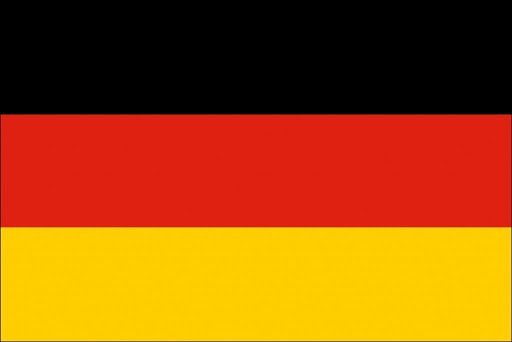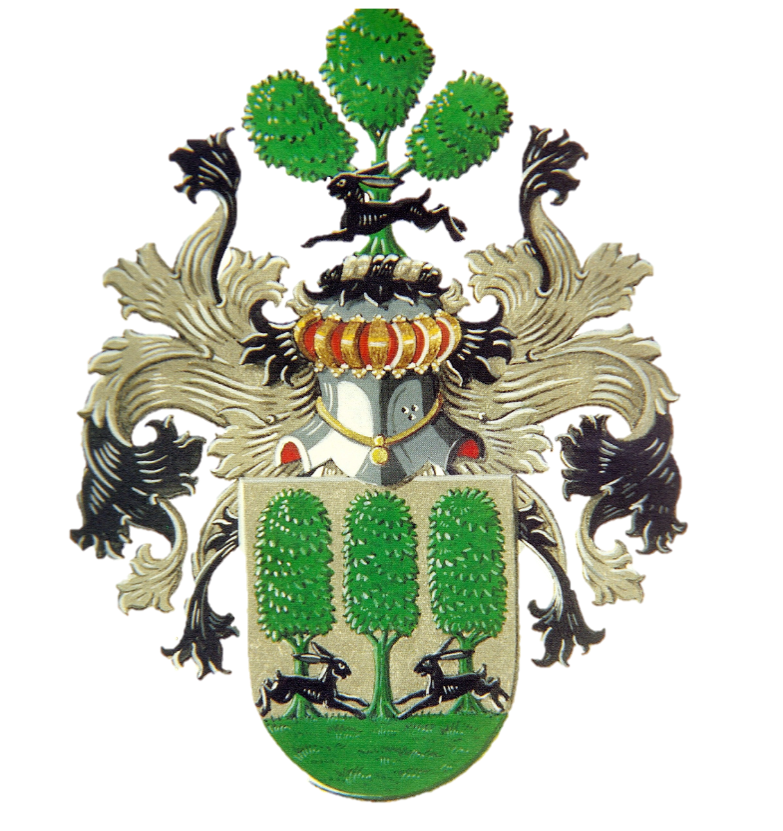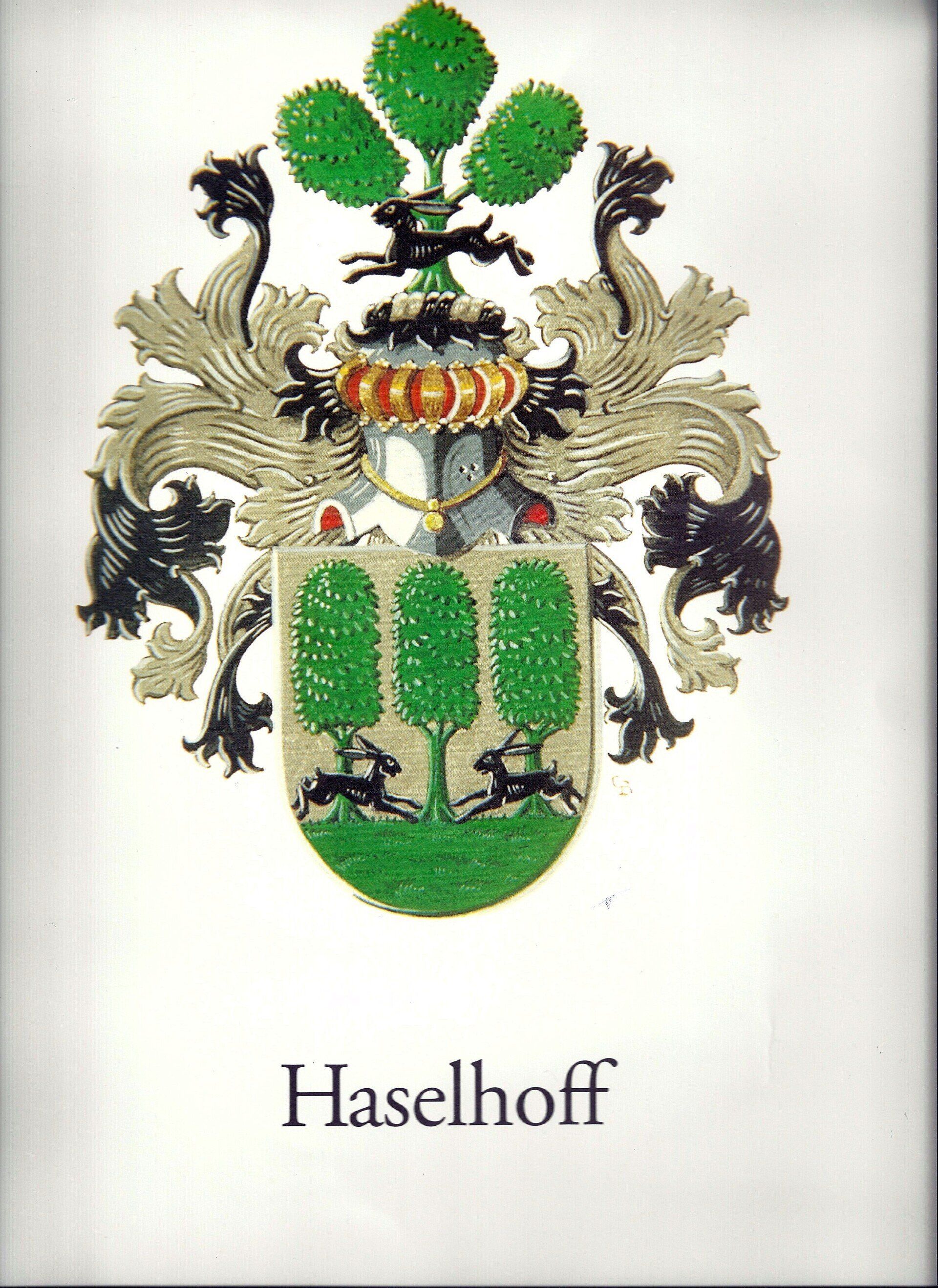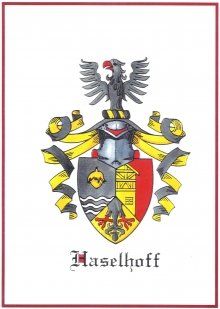The description of the weapon (CBG Yearbook 1991, part 45, p. 256) reads:
Coat of arms, family and heir names
The two constituent parts 'hasel' and 'hof' are easy to explain at first glance. Hasel is the German word for hazel and hof is the synonym for yard or farm. However, the coat of arms on the tombstone of Derck Haselhoff in Wedde shows a hare and not a hazel.
This is also the case on a presumably 19th century signet ring of the Haselhoff family from Grütlohn. Haselhof could then be a corruption of Hazenhof. The 16th century coat of arms by Thomas Haselhofer from Austria, on the other hand, shows a man holding a hazel bush in both hands.
In old sources, the Haselhof yard is also referred to by the Old Germanic word Haselahe or Haselaha, an area where hazel trees grow. The word 'hof' then stands for a (demarcated) area. The name Haselhof could also indicate a Saxon ding place, a place where justice was administered. A place that, according to historical sources, consisted of an enclosure of hazel branches, which were interconnected with cords. Until the Middle Ages, the Haselhof in Marbeck near Borken was such a place where justice was administered, the Freistuhl Haselhof. The double f after the name means as much as coming from (the Haselhof yard).
family coat of arms
The Haselhoff family coat of arms, registered on 19 June 1990 at the Central Bureau of Genealogy (CBG) in The Hague under number 510 in the Weapons Register, has a history of more than 350 years.
The oldest found mention of the coat of arms is on the stone of the double grave of Derck Haselhoff (died 1650) and his wife Magdalena Saxenhausen (died 1669). The double grave is located in the cemetery at the Reformed Church in Wedde
The coat of arms is divided into four:
I. Three trees on a terrace and a leaping hare in front of the top trees, the hares facing each other.II. A man with a wide-brimmed hat seated on a galloping horse.III. Three houses together, each with a gable and a door and three windows (one above and two below) IV. A lion. As a helmet sign a tree with three crowns with a leaping hare in front of it.
Origin and distribution
Westphalia, cradle of the Dutch families
The family name Haselhof(f) is originally from Westphalia. In the vicinity of the cities of Dortmund and Borken, the name has been used as a family name since the Middle Ages. In 1308 Johan Haselhof is registered as a citizen in the Civic Book of Dortmund. And in a tax register of the bisdom Munster, around 1500 Johan then Haselhove from Borken, Gese then Haselhove from Grütlohn and Schulte ton Haselhove from Marbeck are mentioned. Grütlohn and Marbeck are villages in the vicinity of Borken. And although the name Haselhof(f) has spread over large parts of Germany over the centuries, we still see the greatest concentrations of the name in and around the cities mentioned. of Dortmund and its environs mainly converted to the Protestant faith, while the Borken region as part of the Diocese of Munster remains Catholic. This is also reflected in the religious affiliation of the Dutch name bearers. Derck Haselhoff from Wedde and his descendants are protestants, as are the Middelburg family branch. Johannes Adolphus Haselhoff from Huissen and his descendants are Catholic.
The names Hasselhof (f), Haseloff and Haselhofer
In addition to Haselhof(f), there are three other variants in Germany: Hasselhof(f), Haseloff and Haselhofer. Hasselhoff is a name that originates from Lower Saxony, mainly from the region south-east of Bremen. The name also occurs as a misspelling of the name Haselhoff, sometimes also as Haßelhoff. The largest concentrations of people with this name can still be found in the regions of Bremen and Dortmund. The name Haseloff has its origin in a yard in the present-day state of Brandenburg. This name is still prevalent in this state and in Berlin. The name Haselhofer is especially common in the vicinity of Ulm in Bavaria. This name originally comes from Austria, a yard southwest of Vienna.
Distribution of the surname around the world
In Europe, the family name is mainly found in Germany and the Netherlands. In the 19th and 20th centuries, many name-bearers emigrated to North and South America, Australia and New Zealand. The family research, which initially focused mainly on Dutch family groups, has expanded over the years to the country of origin (Germany) but also to family groups elsewhere in the world.
Haselhof(f): an heir name
Oldest mentions of the heir name Haselhof(f)
Presumably in the first millennium of the era, the name Haselhof(f) is used to indicate a yard or farm. The oldest written record found so far (1062) concerns a heritage Haselhof northeast of Nuremberg. This is probably the still existing yard of Haselhof near the village of Pettensiedel.
The Haselhof yard on the Hellweg in Wambel is probably even older. This farm still exists, but has since been swallowed up by the rapidly expanding city of Dortmund.
It has since become apparent that dozens of Haselhof heirs, written in different ways, have existed in the German-speaking areas of Europe. Several of these yards still exist and still bear that name, some have grown into hamlets or even a village. The family names Hasselhoff, Haseloff and Haselhofer can also be traced back to a farm name.
From heir name to family name
In Westphalia, but also in Twente and in the Achterhoek it was common for the inhabitants of farms to also use the heir name as a family name. When farmers' sons moved to the cities to settle there in the late Middle Ages, they took the heir as their family name. This allowed the family name Haselhof(f) to spread and expand. The same development has occurred with the heir and family names Hasselhoff from Lower Saxony, Haseloff from Brandenburg and Haselhofer from Austria. It is striking that in other areas where heirs with the name Haselhof(f) arose, the heir name was not used as a family name. For example, there are several Haselhof(f) estates in the state of Bavaria, but the family name does not originate there. The family name Haselhoff, or a variant thereof, therefore originated in a limited number of regions. Perhaps the origin can even be traced back to one or a few tribal heirs, such as the Haselhof heirs in Wambel near Dortmund and in Marbeck near Borken and the Hasselhoff yard in Völkersen near Bremen.
Distribution of the heir name Haselhof(f) across German-speaking Europe
Yards with the name Haselhof(f) can be found in almost all (former) German-speaking areas, including Poland (East) Prussia, the Czech Republic (Bohemia), Austria, Switzerland, Italy (South Tyrol) and France (Alsace). a number of these yards have been established that the name Haselhof was already used in the Middle Ages. A conclusive explanation for the phenomenon that this heir occurs in so many different places and spread over such a large area has not yet been found. Possible explanations could be:
- The farm was given its name because of the meaning of the name Haselhof and/or the existence of a place that already bore that name. The heir/family name Haselhof(f) was taken by settlers in the period 1100-1300. Then Central Europe was colonized and cultivated from the west and from the already inhabited river valleys. An example of this is the Haseloff property in the Fläming region of Brandenburg. In that period, this area was conquered from Slavic tribes and subsequently brought under cultivation by settlers from Flanders and the Rhineland. Sons have taken the name from the parental farm and used it for the farm they founded. This seems to be the case in both the Dortmund and Borken region.
The distribution of the "Haselhoff" heirs in Central Europe is shown in a table.
Dutch families
Variations on the name
From the beginning of the 17th century, the family name Haselhoff occurs in the Netherlands. In present-day Germany, the family name has been used for several centuries.
In 2007 the number of Dutch name bearers was:
| Name: | Number of name bearers: |
|---|---|
| Haselhoff | 50 |
| Haselhof Lich Kasteleijn | 17 |
| Hazelhof | 102 |
| Hazelhoff | 388 |
| Hazelhoff Heeres | 7 |
| Hazelhoff Roelfzema | 13 |
| Hazelof | 19 |
| Total | 596 |
family groups
Almost all name bearers are part of five family groups, which are described in the New Chronicle of the genus Haselhoff. It concerns the descendants of:
- Derck Haselhof(f) (ca. 1600-1650) from Wedde with the related family groups Nanno Doedens and Eppe RoelfsJohannes Adolphus (Albert) Haselhoff (1779-1830) from Huissen;Hendrik Hasel(h)of(f) (ca 1730- 1788) from Middelburg.
Furthermore, in the 17th and 18th centuries there were groups and individual name bearers in the Netherlands that cannot (yet) be related to the above-mentioned family groups.
Johannes Adolphus (Albert) Haselhoff
Albert Haselhoff was born on March 13, 1779 in Rhede and was baptized as a Catholic. Rhede is located in the German state of Lower Saxony, between the cities of Bocholt and Borken. Albert settles as a carpenter in Huissen in Gelderland around 1815 and marries Gerarda Otten around that year. Descendants of them later found work in the Ruhr area and the Limburg mining region. Albert descends from a German Haselhoff family that originated in the village of Grütlohn near Borken. The family takes its name from the Haselhoff farm, which is located there and still exists. Name bearers from this family also live in the United States.
Hendrik Hasel(h)of(f)
The origin of this Hendrik Hasel(h)or(f), who married in Dordrecht in 1761 and died in Middelburg, is not yet clear. As far as is known, he is not descended from any of the aforementioned Dutch family branches. He may be a descendant of a German name-bearer, who came to seek his fortune as a sailor on a ship of the Dutch East India Company (VOC). Several descendants of Hendrik are brushmakers in Middelburg. His family calls itself Hazelof from the third generation.
Other family groups and name bearers
It is known that in the 17th and 18th century there were still a few family groups and different persons with the name Haselhoff living in the Netherlands. Presumably they were name bearers who had come to the Netherlands from the German areas and of whom no progeny is known or whose progeny has become extinct after a few generations. In 1602, for example, the soldier Davidt Haeselloff married in Heusden, whose descendants are known only in the 17th century. Name bearers also lived in Groningen, Deventer, Amsterdam and Leiden, who could not (yet) be associated with another Dutch family branch.
Derck Haselhoff
Who is Derck Haselhoff, the ancestor of most name bearers who live or have lived in the Netherlands? Derck Haselhoff was born between 1600 and 1605, he became a veltscheerder in the Schay company and married Geertruid Luckas from Bellingwolsterzijl on February 24, 1628 in Oudeschans, who died about 1635. In 1636 Derck married for the second time to Magdalena Saxenhausen. In 1637 he became borggraaf at the drost of Wedde and Westerwolde. He lives opposite the castle in Wedde in the Borggraafhuis and works at the castle. His position is an important one at that time. In addition to police duties, such as tracing and detaining criminals, he also has the function of informant for the justice of the drost. He must also collect the fines that have been imposed. Except as borggraaf, Derck is also a tenant of leases, which means that he collects taxes and other levies. A task that is leased by the rightful claimant (government). In addition to the Borggraaf house in Wedde, Derck Haselhoff, possibly as a tenant, also acquires the Joling yard in nearby Hoorn. This yard also contains two graves in the cemetery of Wedde. Derck and his wife Magdalena Saxenhausen were later buried in these graves. Derck remained borggraaf until his death in 1650. Two family groups started using the name Hazelhoff in the early 19th century, without there being any direct descent from the Derck Haselhoff family. However, indirect links with this family can be demonstrated. It concerns the families Nanno Doedens and Eppe Roelfs. These families spread over the centuries from East Groningen over the Netherlands. Several families have also emigrated, including to North and South America, Australia and New Zealand








